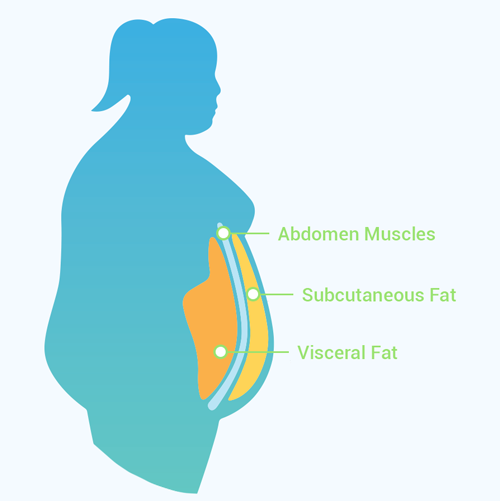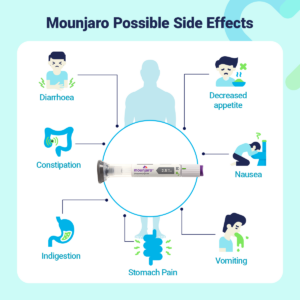All you should know about visceral fat
There are several different types of fat in the human body, with the most dangerous being visceral fat.
We explain what it is, where it’s stored, and what you can do to reduce the amount of visceral fat in your body.
What is visceral fat?
Visceral fat describes fat that’s stored around your organs and inside your abdomen.
This isn’t the fat that you can sometimes feel if you pinch your belly, but visceral fat lies much deeper and can affect some major organs if levels become too high.
Around 10% of our body’s total fat is stored as visceral fat, so it stands to reason that if you’re carrying some extra weight, then you may also be carrying some excess visceral fat, which can become dangerous for your health, particularly if your visceral fat levels keep on increasing, as is the case with many people who struggle with obesity.
What causes visceral fat?
Visceral fat has various contributing factors, as does obesity, and as excess visceral fat is a product of obesity, the two tend to go hand in hand as far as causes are concerned.
In simple terms, visceral fat is caused by consuming more energy than we need or can burn off, so whatever we don’t use is stored as fat.
As 10% of our body’s total fat is visceral, the more we gain weight, the more visceral fat there is.
However, there’s another factor to visceral fat that’s important; and that’s stress.
When we’re stressed, our bodies release a hormone called cortisol. Now, certain levels of cortisol can be good for us, but if we experience high levels of the hormone for prolonged amounts of time, it can cause problems.
If you’re chronically stressed, you may find that you have more belly fat. This is because cortisol can actively increase the amount of visceral fat between your organs.
Because of this, many healthcare professionals recommend that you keep your stress levels low if you’re trying to lose weight. It may be worth tracking your mood in a diary or wellness app to determine what makes you stressed, as this may help you to identify how to help yourself.
If you’re particularly struggling, you may find it useful to try talking therapies, which you should be able to access via your own GP.
Looking after your mental health is just as important as looking after your physical health, especially when it comes to weight management, as a stable and positive mindset can often make a difference when it comes to long-term weight loss goals.
Dangers of visceral fat
Whilst an excessive amount of any type of fat isn’t good for your health, a lot of belly fat can be particularly dangerous due to the fact that it is close to vital organs.
Viscercal fat is sometimes called “active fat”, as the fat cells inside the abdominal cavity actually secrete various hormones and proteins.
One of the proteins that visceral fat cells secrete is known to lead to insulin resistance – something that many people with type 2 diabetes mellitus suffer with.
However, if visceral fat levels are high, it can cause insulin resistance without any indication of diabetes.
In other words, your blood glucose may be fine, but your body can still become resistant to insulin due to the amount of visceral fat in your abdomen.
Having insulin resistance also increases your risk of developing TD2M, as insulin needs to act effectively without resistance to control glucose levels.
Another protein produced by these fat cells can increase your blood pressure – something that you want to avoid at all times, but particularly if you’re carrying extra weight.
Visceral fat also produces certain proteins that are linked to inflammation.
Because fat is something that takes a while to lose, this could mean experiencing chronic, low-grade inflammation for quite some time, which can also increase your risk of some major health issues.
In addition to the above, higher than normal levels of belly fat can also significantly increase your risk of developing serious health conditions such as:
- Heart disease
- Stroke
- Coronary artery disease
- Atherosclerosis
- Complications in pregnancy
- Type 2 diabetes mellitus
- Hormone imbalances
- Some cancers
How can I check my visceral fat level?
The only definite way to determine how much visceral fat you have is to have an MRI scan that clearly shows fat between the organs.
However, MRI scans for visceral fat checking aren’t routinely done on the NHS, so you would have to pay privately for this.
However, there are other methods that you can try at home to work out your own visceral fat levels – all you need is a measuring tape (and a calculator, unless you’re great at mental maths!).
For all of the methods we’re going to explain, you’ll need to find and measure your waist (usually located just above the bellybutton).
Remember, whenever you measure yourself, you should stand up straight and relax your muscles for a true reading.
Waist circumference can tell us a lot about our body fat, as you’re more likely to have more belly fat with a larger waist circumference.
For women, a waist measurement of 35 inches or more indicates excess visceral fat.
For men, this measurement increases to 40 inches or more.
Another way that you can measure your estimated levels of visceral fat is to use the waist to hip ratio method.
For this, you’ll first have to find and measure your waist, and take note of the measurement.
Next, you should measure the widest part of your hips. You may need to do this in a mirror so that you can see where your widest part is.
Finally, you should divide your waist measurement by your hip circumference to find out what your ratio is.
It’s generally recommended that for women, the ratio should be under 0.85, and for men, it should be 0.90.
If your reading is higher than this, it indicates abdominal obesity and the presence of excess visceral fat.
There’s also a third way of measuring your belly fat, called the waist to height ratio.
First, choose whether you’re going to measure in centimetres or inches, as you’ll need to measure both your waist and your height in the same units.
Next, measure your height (shoes off, and standing up straight), then your waist.
Divide your waist circumference by your height, and you should end up with your waist to height ratio.
Generally speaking, this number should fall under 0.50. Again, if your measurement is higher than this, then you’re likely to have excess visceral fat which could be putting your health at risk.
How to reduce visceral fat
Whilst excess belly fat can spell bad news for your health, the good news is that there are steps that you can take to reduce it if you have too much of it.
Luckily, weight management techniques such as increasing your physical activity, eating healthily and making other lifestyle changes have been proven to be effective in reducing the amount of visceral fat a person has.
It’s generally recommended that for weight loss, cardio or aerobic exercises are the most effective.
This essentially includes most exercise that raises your heart and breathing rates.
Loads of sports and activities are included in this, such as dancing, running, brisk walking, cycling, badminton, football – anything that gets you working to a point of being able to talk, but not sing (this example is often used to describe how moderate exercise should feel).
As a guide, you should be aiming to do around 2 and a half hours of moderate exercise per week in any aerobic activity that you choose.
If you enjoyed playing netball or basketball at school, there’s no time like the present to go back to an old hobby!
Have a look in your local community for any group sports that you might be interested in, or if you prefer to go it alone, have a think about some activities you’d like to try.
When it comes to diet, for weight loss, you should make sure that you aren’t eating more calories than your body requires.
You’ll also burn more calories if you increase your physical activity levels, which can give your weight loss a boost.
If you’re adjusting your diet to help yourself lose weight, then we recommend looking at recommended portion sizes for every food and nutrient group (available on most food packaging), and also opting for foods that are likely to keep you fuller for longer, but that are also fairly low in calories.
Protein and fibre are both great options for keeping yourself feeling full without eating too many calories.
You’re still allowed to eat some fats whilst you’re on a weight management journey and trying to lose belly fat – but we need much less of it than other food groups.
Fats should be used sparingly, or eaten as an occasional treat because of the high-calorie values that fatty foods have.
Because of this, when you eat a lot of fatty foods, it becomes easy to over-consume calories. Over time, this can increase the amount of fat in your body, including viscerally.
Semaglutide can help to increase how much weight you’d lose through diet and exercise alone, as most people that take it have struggled to lose weight naturally.
Because of the way that semaglutide works in your body, you’re likely to eat smaller portions, and with myBMI providing lots of great support to do with diet, exercise, education and medical therapy, reducing your visceral fat levels is an achievable goal.


















